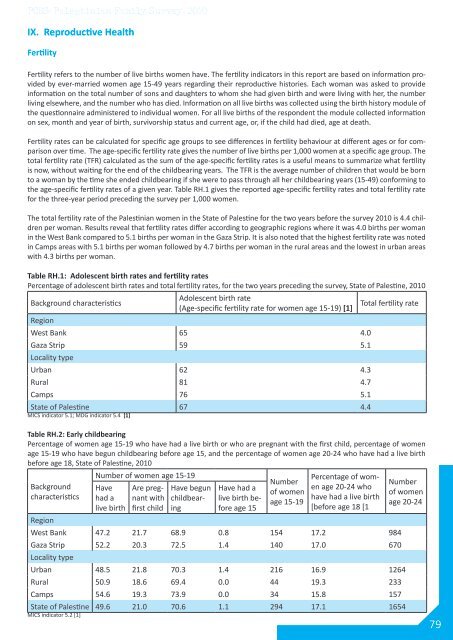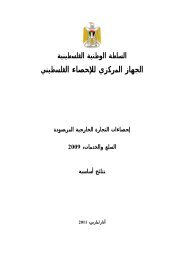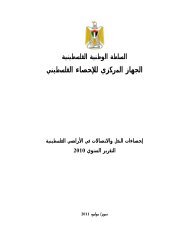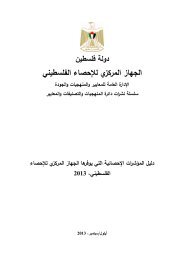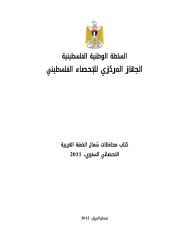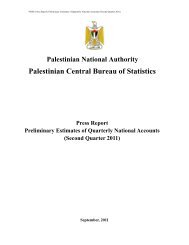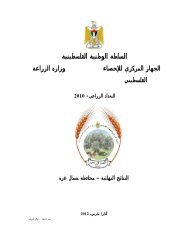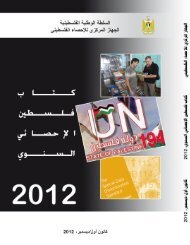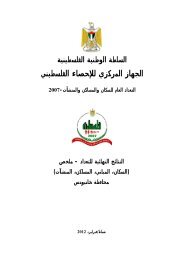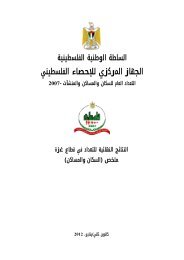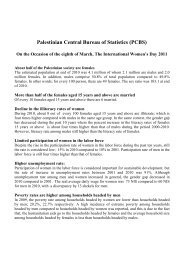Palestinian Family Survey 2010 Final Report - Palestinian Central ...
Palestinian Family Survey 2010 Final Report - Palestinian Central ...
Palestinian Family Survey 2010 Final Report - Palestinian Central ...
- No tags were found...
Create successful ePaper yourself
Turn your PDF publications into a flip-book with our unique Google optimized e-Paper software.
PCBS: <strong>Palestinian</strong> <strong>Family</strong> <strong>Survey</strong>, <strong>2010</strong>IX. Reproductive HealthFertilityFertility refers to the number of live births women have. The fertility indicators in this report are based on information providedby ever-married women age 15-49 years regarding their reproductive histories. Each woman was asked to provideinformation on the total number of sons and daughters to whom she had given birth and were living with her, the numberliving elsewhere, and the number who has died. Information on all live births was collected using the birth history module ofthe questionnaire administered to individual women. For all live births of the respondent the module collected informationon sex, month and year of birth, survivorship status and current age, or, if the child had died, age at death.Fertility rates can be calculated for specific age groups to see differences in fertility behaviour at different ages or for comparisonover time. The age-specific fertility rate gives the number of live births per 1,000 women at a specific age group. Thetotal fertility rate (TFR) calculated as the sum of the age-specific fertility rates is a useful means to summarize what fertilityis now, without waiting for the end of the childbearing years. The TFR is the average number of children that would be bornto a woman by the time she ended childbearing if she were to pass through all her childbearing years (15-49) conforming tothe age-specific fertility rates of a given year. Table RH.1 gives the reported age-specific fertility rates and total fertility ratefor the three-year period preceding the survey per 1,000 women.The total fertility rate of the <strong>Palestinian</strong> women in the State of Palestine for the two years before the survey <strong>2010</strong> is 4.4 childrenper woman. Results reveal that fertility rates differ according to geographic regions where it was 4.0 births per womanin the West Bank compared to 5.1 births per woman in the Gaza Strip. It is also noted that the highest fertility rate was notedin Camps areas with 5.1 births per woman followed by 4.7 births per woman in the rural areas and the lowest in urban areaswith 4.3 births per woman.Table RH.1: Adolescent birth rates and fertility ratesPercentage of adolescent birth rates and total fertility rates, for the two years preceding the survey, State of Palestine, <strong>2010</strong>Background characteristicsAdolescent birth rate(Age-specific fertility rate for women age 15-19) [1]Total fertility rateRegionWest Bank 65 4.0Gaza Strip 59 5.1Locality typeUrban 62 4.3Rural 81 4.7Camps 76 5.1State of Palestine 67 4.4MICS indicator 5.1; MDG indicator 5.4 ]1[Table RH.2: Early childbearingPercentage of women age 15-19 who have had a live birth or who are pregnant with the first child, percentage of womenage 15-19 who have begun childbearing before age 15, and the percentage of women age 20-24 who have had a live birthbefore age 18, State of Palestine, <strong>2010</strong>BackgroundcharacteristicsNumber of women age 15-19Havehad alive birthAre pregnantwithfirst childHave begunchildbearingHave had alive birth beforeage 15Numberof womenage 15-19Percentage of womenage 20-24 whohave had a live birth]before age 18 [1Numberof womenage 20-24RegionWest Bank 47.2 21.7 68.9 0.8 154 17.2 984Gaza Strip 52.2 20.3 72.5 1.4 140 17.0 670Locality typeUrban 48.5 21.8 70.3 1.4 216 16.9 1264Rural 50.9 18.6 69.4 0.0 44 19.3 233Camps 54.6 19.3 73.9 0.0 34 15.8 157State of Palestine 49.6 21.0 70.6 1.1 294 17.1 1654MICS indicator 5.2 ]1[79


